Very Good Advice For Both The Writer And The Critiquer.


Very good advice for both the writer and the critiquer.
More Posts from Lovespiralls and Others

Hogwarts Inspired Writing Prompts
Writing Prompts
As kids, A would always tell B that they’re magic and have magic powers. B didn’t believe them, of course. Now as they reunite during the Hogwarts sorting ceremony, B realises that A was right.
After A is kicked from their quidditch team and replaced with B, A sneaks into their quidditch games and messes with B in the air.
After learning at Hogwarts used to have lots of balls, secret societies, lectures, and other forgotten activities, a group of enthusiastic friends decide to revive those traditions.
A group of restless students decide to form a protest over an arbitrary school issue. They don’t really care about the issue, they just want to do lock-outs, parade around with signs, and do over-the-top displays of rebellion.
A discovers that their best friend B is writing a novel and some of the characters resemble their friend group. To mess with B, A and their friends start reenacting some of the scenes of the book and acting like the characters in it.
Short prompts
An overly competitive game of chess
Getting locked in the library
Conversing with ghosts
The dramatic end to a life long rivalry
Pulling a prank on the wrong person
Studying by candlelight
Anonymous notes
Secretly exchanging potions
Ink stains
Sewing patches to your robes
Oneliners
“Real magic doesn’t come from wands. It’s all around us”
“This club is exclusive— I shouldn’t even be telling you about it”
“There’s more to life than transfiguration”
“Why aren’t you going home for the summer?”
“Then let’s settle this like men: with a duel”
“Weren’t you expelled?” “Yes. But when has that ever stopped me?”
“I snuck this in from the Forbidden Forest”
“I never thought the dungeons were used as actual dungeons”
“This wall is begging for a mural”
“This is Hogwarts. It’s full of secrets”
Also see:
Studying OTP prompts and oneliners
Writing prompts masterlist

Let me know if you like this style of prompts!
Words for Skin Tone | How to Describe Skin Color
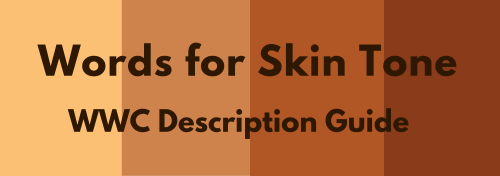
We discussed the issues describing People of Color by means of food in Part I of this guide, which brought rise to even more questions, mostly along the lines of “So, if food’s not an option, what can I use?” Well, I was just getting to that!
This final portion focuses on describing skin tone, with photo and passage examples provided throughout. I hope to cover everything from the use of straight-forward description to the more creatively-inclined, keeping in mind the questions we’ve received on this topic.
Standard Description
Basic Colors

Pictured above: Black, Brown, Beige, White, Pink.
“She had brown skin.”
This is a perfectly fine description that, while not providing the most detail, works well and will never become cliché.
Describing characters’ skin as simply brown or beige works on its own, though it’s not particularly telling just from the range in brown alone.
Complex Colors
These are more rarely used words that actually “mean” their color. Some of these have multiple meanings, so you’ll want to look into those to determine what other associations a word might have.

Pictured above: Umber, Sepia, Ochre, Russet, Terra-cotta, Gold, Tawny, Taupe, Khaki, Fawn.
Complex colors work well alone, though often pair well with a basic color in regards to narrowing down shade/tone.
For example: Golden brown, russet brown, tawny beige…
As some of these are on the “rare” side, sliding in a definition of the word within the sentence itself may help readers who are unfamiliar with the term visualize the color without seeking a dictionary.
“He was tall and slim, his skin a russet, reddish-brown.”
Comparisons to familiar colors or visuals are also helpful:
“His skin was an ochre color, much like the mellow-brown light that bathed the forest.”
Modifiers
Modifiers, often adjectives, make partial changes to a word.The following words are descriptors in reference to skin tone.
Dark - Deep - Rich - Cool
Warm - Medium - Tan
Fair - Light - Pale
Rich Black, Dark brown, Warm beige, Pale pink…
If you’re looking to get more specific than “brown,” modifiers narrow down shade further.
Keep in mind that these modifiers are not exactly colors.
As an already brown-skinned person, I get tan from a lot of sun and resultingly become a darker, deeper brown. I turn a pale, more yellow-brown in the winter.
While best used in combination with a color, I suppose words like “tan” “fair” and “light” do work alone; just note that tan is less likely to be taken for “naturally tan” and much more likely a tanned White person.
Calling someone “dark” as description on its own is offensive to some and also ambiguous. (See: Describing Skin as Dark)
Undertones
Undertones are the colors beneath the skin, seeing as skin isn’t just one even color but has more subdued tones within the dominating palette.
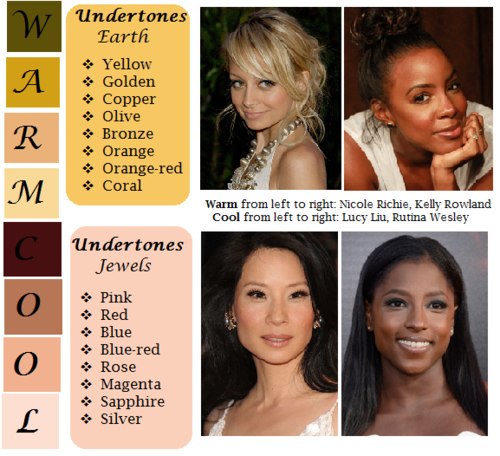
pictured above: warm / earth undertones: yellow, golden, copper, olive, bronze, orange, orange-red, coral | cool / jewel undertones: pink, red, blue, blue-red, rose, magenta, sapphire, silver.
Mentioning the undertones within a character’s skin is an even more precise way to denote skin tone.
As shown, there’s a difference between say, brown skin with warm orange-red undertones (Kelly Rowland) and brown skin with cool, jewel undertones (Rutina Wesley).
“A dazzling smile revealed the bronze glow at her cheeks.”
“He always looked as if he’d ran a mile, a constant tinge of pink under his tawny skin.”
Standard Description Passage
“Farah’s skin, always fawn, had burned and freckled under the summer’s sun. Even at the cusp of autumn, an uneven tan clung to her skin like burrs. So unlike the smooth, red-brown ochre of her mother, which the sun had richened to a blessing.”
-From my story “Where Summer Ends” featured in Strange Little Girls
Here the state of skin also gives insight on character.
Note my use of “fawn” in regards to multiple meaning and association. While fawn is a color, it’s also a small, timid deer, which describes this very traumatized character of mine perfectly.
Though I use standard descriptions of skin tone more in my writing, at the same time I’m no stranger to creative descriptions, and do enjoy the occasional artsy detail of a character.
Creative Description
Whether compared to night-cast rivers or day’s first light…I actually enjoy seeing Characters of Colors dressed in artful detail.
I’ve read loads of descriptions in my day of white characters and their “smooth rose-tinged ivory skin”, while the PoC, if there, are reduced to something from a candy bowl or a Starbucks drink, so to actually read of PoC described in lavish detail can be somewhat of a treat.
Still, be mindful when you get creative with your character descriptions. Too many frills can become purple-prose-like, so do what feels right for your writing when and where. Not every character or scene warrants a creative description, either. Especially if they’re not even a secondary character.
Using a combination of color descriptions from standard to creative is probably a better method than straight creative. But again, do what’s good for your tale.
Natural Settings - Sky

Pictured above: Harvest Moon -Twilight, Fall/Autumn Leaves, Clay, Desert/Sahara, Sunlight - Sunrise - Sunset - Afterglow - Dawn- Day- Daybreak, Field - Prairie - Wheat, Mountain/Cliff, Beach/Sand/Straw/Hay.
Now before you run off to compare your heroine’s skin to the harvest moon or a cliff side, think about the associations to your words.
When I think cliff, I think of jagged, perilous, rough. I hear sand and picture grainy, yet smooth. Calm. mellow.
So consider your character and what you see fit to compare them to.
Also consider whose perspective you’re describing them from. Someone describing a person they revere or admire may have a more pleasant, loftier description than someone who can’t stand the person.
“Her face was like the fire-gold glow of dawn, lifting my gaze, drawing me in.”
“She had a sandy complexion, smooth and tawny.”
Even creative descriptions tend to draw help from your standard words.
Flowers
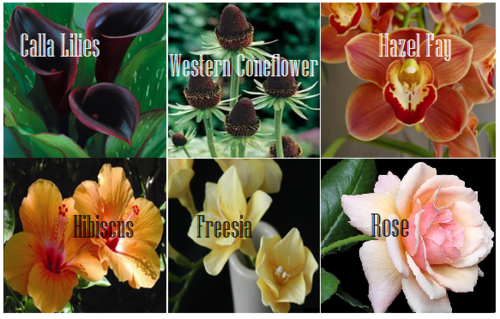
Pictured above: Calla lilies, Western Coneflower, Hazel Fay, Hibiscus, Freesia, Rose
It was a bit difficult to find flowers to my liking that didn’t have a 20 character name or wasn’t called something like “chocolate silk” so these are the finalists.
You’ll definitely want to avoid purple-prose here.
Also be aware of flowers that most might’ve never heard of. Roses are easy, as most know the look and coloring(s) of this plant. But Western coneflowers? Calla lilies? Maybe not so much.
“He entered the cottage in a huff, cheeks a blushing brown like the flowers Nana planted right under my window. Hazel Fay she called them, was it?”
Assorted Plants & Nature

Pictured above: Cattails, Seashell, Driftwood, Pinecone, Acorn, Amber
These ones are kinda odd. Perhaps because I’ve never seen these in comparison to skin tone, With the exception of amber.
At least they’re common enough that most may have an idea what you’re talking about at the mention of “pinecone."
I suggest reading out your sentences aloud to get a better feel of how it’ll sounds.
"Auburn hair swept past pointed ears, set around a face like an acorn both in shape and shade.”
I pictured some tree-dwelling being or person from a fantasy world in this example, which makes the comparison more appropriate.
I don’t suggest using a comparison just “cuz you can” but actually being thoughtful about what you’re comparing your character to and how it applies to your character and/or setting.
Wood

Pictured above: Mahogany, Walnut, Chestnut, Golden Oak, Ash
Wood can be an iffy description for skin tone. Not only due to several of them having “foody” terminology within their names, but again, associations.
Some people would prefer not to compare/be compared to wood at all, so get opinions, try it aloud, and make sure it’s appropriate to the character if you do use it.
“The old warlock’s skin was a deep shade of mahogany, his stare serious and firm as it held mine.”
Metals

Pictured above: Platinum, Copper, Brass, Gold, Bronze
Copper skin, brass-colored skin, golden skin…
I’ve even heard variations of these used before by comparison to an object of the same properties/coloring, such as penny for copper.
These also work well with modifiers.
“The dress of fine white silks popped against the deep bronze of her skin.”
Gemstones - Minerals
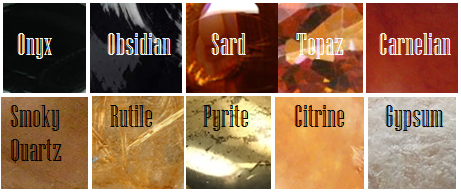
Pictured above: Onyx, Obsidian, Sard, Topaz, Carnelian, Smoky Quartz, Rutile, Pyrite, Citrine, Gypsum
These are trickier to use. As with some complex colors, the writer will have to get us to understand what most of these look like.
If you use these, or any more rare description, consider if it actually “fits” the book or scene.
Even if you’re able to get us to picture what “rutile” looks like, why are you using this description as opposed to something else? Have that answer for yourself.
“His skin reminded her of the topaz ring her father wore at his finger, a gleaming stone of brown, mellow facades.”
Physical Description
Physical character description can be more than skin tone.
Show us hair, eyes, noses, mouth, hands…body posture, body shape, skin texture… though not necessarily all of those nor at once.
Describing features also helps indicate race, especially if your character has some traits common within the race they are, such as afro hair to a Black character.
How comprehensive you decide to get is up to you. I wouldn’t overdo it and get specific to every mole and birthmark. Noting defining characteristics is good, though, like slightly spaced front teeth, curls that stay flopping in their face, hands freckled with sunspots…
General Tips
Indicate Race Early: I suggest indicators of race be made at the earliest convenience within the writing, with more hints threaded throughout here and there.
Get Creative On Your Own: Obviously, I couldn’t cover every proper color or comparison in which has been “approved” to use for your characters’ skin color, so it’s up to you to use discretion when seeking other ways and shades to describe skin tone.
Skin Color May Not Be Enough: Describing skin tone isn’t always enough to indicate someone’s ethnicity. As timeless cases with readers equating brown to “dark white” or something, more indicators of race may be needed.
Describe White characters and PoC Alike: You should describe the race and/or skin tone of your white characters just as you do your Characters of Color. If you don’t, you risk implying that White is the default human being and PoC are the “Other”).
PSA: Don’t use “Colored.” Based on some asks we’ve received using this word, I’d like to say that unless you or your character is a racist grandmama from the 1960s, do not call People of Color “colored” please.
Not Sure Where to Start? You really can’t go wrong using basic colors for your skin descriptions. It’s actually what many people prefer and works best for most writing. Personally, I tend to describe my characters using a combo of basic colors + modifiers, with mentions of undertones at times. I do like to veer into more creative descriptions on occasion.
Want some alternatives to “skin” or “skin color”? Try: Appearance, blend, blush, cast, coloring, complexion, flush, glow, hue, overtone, palette, pigmentation, rinse, shade, sheen, spectrum, tinge, tint, tone, undertone, value, wash.
Skin Tone Resources
List of Color Names
The Color Thesaurus
Skin Undertone & Color Matching
Tips and Words on Describing Skin
Photos: Undertones Described (Modifiers included)
Online Thesaurus (try colors, such as “red” & “brown”)
Don’t Call me Pastries: Creative Skin Tones w/ pics I
Writing & Description Guides
WWC Featured Description Posts
WWC Guide: Words to Describe Hair
Writing with Color: Description & Skin Color Tags
7 Offensive Mistakes Well-intentioned Writers Make
I tried to be as comprehensive as possible with this guide, but if you have a question regarding describing skin color that hasn’t been answered within part I or II of this guide, or have more questions after reading this post, feel free to ask!
~ Mod Colette
WEBSITES FOR WRITERS {masterpost}
E.A. Deverell - FREE worksheets (characters, world building, narrator, etc.) and paid courses;
Rach Academia - FREEBIES (workbook, notion template, games, challenges, etc.);
Hiveword - Helps to research any topic to write about (has other resources, too);
BetaBooks - Share your draft with your beta reader (can be more than one), and see where they stopped reading, their comments, etc.;
Charlotte Dillon - Research links;
Writing realistic injuries - The title is pretty self-explanatory: while writing about an injury, take a look at this useful website;
One Stop for Writers - You guys... this website has literally everything we need: a) Description thesaurus collection, b) Character builder, c) Story maps, d) Scene maps & timelines, e) World building surveys, f) Worksheets, f) Tutorials, and much more! Although it has a paid plan ($90/year | $50/6 months | $9/month), you can still get a 2-week FREE trial;
One Stop for Writers Roadmap - It has many tips for you, divided into three different topics: a) How to plan a story, b) How to write a story, c) How to revise a story. The best thing about this? It's FREE!
Story Structure Database - The Story Structure Database is an archive of books and movies, recording all their major plot points;
National Centre for Writing - FREE worksheets and writing courses. Has also paid courses;
Penguin Random House - Has some writing contests and great opportunities;
Crime Reads - Get inspired before writing a crime scene;
The Creative Academy for Writers - "Writers helping writers along every step of the path to publication." It's FREE and has ZOOM writing rooms;
Reedsy - "A trusted place to learn how to successfully publish your book" It has many tips, and tools (generators), contests, prompts lists, etc. FREE;
QueryTracker - Find agents for your books (personally, I've never used this before, but I thought I should feature it here);
Pacemaker - Track your goals (example: Write 50K words - then, everytime you write, you track the number of the words, and it will make a graphic for you with your progress). It's FREE but has a paid plan;
Save the Cat! - The blog of the most known storytelling method. You can find posts, sheets, a software (student discount - 70%), and other things;
I hope this is helpful for you!
Also, don't forget to check my gumroad shop, where you can find plenty of FREEBIES (from notion templates for writers to workbooks and sheets).
-> Check out my freebies
Happy writing! <3
As you write, you will naturally improve. Do not wait until you think you are good enough to start. You are always good enough to start improving.
If you’re having writers block…READ!!!! CONSUME MEDIA
I feel like I don’t hear that given enough as advice for writers block..just read? Watch tv? Movies? Find inspiration in media.
Writers block is a lack of inspiration, so go collect more.
couples who aren’t together just yet ˗ˏˋ꒰ 🐚 ꒱
— “can i come over tonight? is that stupid to ask?”
— “come on, talk to me. when have i ever led you astray, hm?”
— “will you hold my hand?”
— “i want nothing more than to kiss you right now.”
— “you’re always going to be the most beautiful person in the room to me.”
— “i’m so proud of you- you know that, right?”
— “you matter so much to me.”
— “is it okay if i stay at yours tonight? i don’t know if i can stand another night away from you.”
— “just let me love you!”
— “am i dumb for thinking there’s something here? something that could be real?”
— “i’m sorry, but they don’t deserve you.”
— “can we just... can we give this a chance?”
— “i know it’s wrong of me to come crying to you over a date, but i didn’t know where else to go.”
— “you make me feel so safe.”
— “i love you. as more than just a friend.”
What people think writers’ search histories look like: how to get away with murder, best way to dispose of a body, how long do humans take to decompose, how much blood do you have to lose to die, can i strangle someone with dental floss... etc
What an actual writer’s seach history looks like:

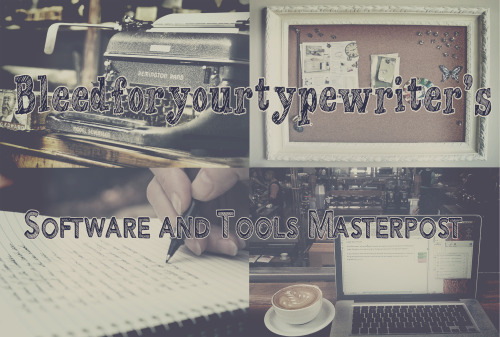
Ok here is a compilation of all the software and useful tools I’ve come across whilst writing. Some of them I’ve reviewed on here already, more coming soon.
Got an idea? Well get planning! Here’s some useful outlining, brainstorming and mind- mapping software:
Coggle
Lucidchart
Mural.ly
Blumind
MindMeister
Mindmaple
Mindomo
NovaMind
Popplet
Scapple
Tree Sheets
Visual Understanding Environment (VUE)
XMind
FreeMind
Oak Outliner
Work Flowy
The Outliner of Giants
Just want to get writing? You want a word processor:
Gedit
Google Docs
Kate
LibreOffice
Microsoft Word
My Writing Spot
NoteTab
Open Office
Quabel
Ted
Vim
yEdit
Making notes? Here you go:
CintaNotes
Evernote
KeepNote
Memonic
MS OneNote
Scribe
SuperNotecard
Tomboy
Timelines giving you a headache? Try these:
Aeon Timeline
Dipity
Preceden
Tiki-Toki
Timeglider
Timeline
TimelineJS
TimeToast
Now perhaps you want to organise those notes. Got a lot of research? Character sheets? Images? Well here’s some tools to keep all that together:
Liquid Story Binder XE
LitLift
PangurPad
Scriptito
Scrivener
Writer’s Café
Yarny
yWriter
Are you easily distracted? The following tools will keep you on track:
Dark Room
FocusWriter
JDarkRoom
Momentum Writer
OmmWriter
Q10
Writemonkey
Zen Writer
Even more productivity tools to help keep you focussed on your task:
Cold Turkey
FocalFilter
Freedom
InternetOff
Keepmeout
Nanny
Productivity Owl
RescueTime
SelfControl
SelfRestraint
Simple Blocker
StayFocusd
Strict Workflow
Time Doctor
Waste No Time
Website Blocker
So you’ve got something down? Need to edit?
AutoCrit
EditMinion
Grammarly
LyX
SlickWrite
SmartEdit
After the Deadline
All done? Perhaps you’d like some e-publishing tools:
Acrobat
InDesign
Calibre
CutePDF
Jutoh
Mobipocket Creator
PagePlus
PageStream
PDFCreator
Scribus
Sigil
Turns out I’d forgotten about screenwriters, so here goes:
CeltX
Plotbot
Scripped
ScriptBuddy
Trelby
WriterDuet
Slugline
Page2Stage
Highland
I’m feeling generous, have some more cool stuff:
750 Words
One Page per Day
Oneword
Penzu
Write or Die
Written Kitten
Focus Booster
Spaaze
AutoREALM (Map building software)
ETA: After a request I’ve added screenplay software to the list.
Best Prompts of 2024!
Prompt #1089: “Why did you come back?” “Because I forgot something important.” “Oh, what did you forget?” “You, you idiot.”
Prompt #1070: “Sorry I tried to kill you.” “It’s fine, but next time you should try harder.”
Prompt #1103: “Stop following me.” “Oh, do you want me to walk beside you? Maybe hold hands with you?”
Prompt #1101: “I’m not the right person for you.” “You’re doing a bad job of convincing me of that.”
Prompt #1082: “You’re just as bad as I am.” “Oh believe me, I’m much worse.”
Prompt #1099: “Have I ever given up on you?” “No, never.” “Then don’t force me to do it now.”
Prompt #1073: Sometimes guardian angels don’t have a lovely singing voice and a set of fluffy wings, sometimes they have a deep frown on their face and a very bad attitude.
Prompt #1078: “Why do you think that you need to fix me? Who told you I was broken?”
Prompt #1062: “Don’t look at me like that.” “How am I looking at you?” “Like you love me.”
Prompt #1092: “If I had asked, would you have stayed?” “You didn’t ask. So we’ll never know.”
Goodbye 2024 and hello 2025! I wish you all a wonderful start into the new year!
If you like my blog and want to support me, you can buy me a coffee or become a member! 🥰
-
 inchofsalt liked this · 2 weeks ago
inchofsalt liked this · 2 weeks ago -
 razerathane reblogged this · 2 weeks ago
razerathane reblogged this · 2 weeks ago -
 tumblahser liked this · 2 weeks ago
tumblahser liked this · 2 weeks ago -
 11rooks liked this · 2 weeks ago
11rooks liked this · 2 weeks ago -
 simplesoftware liked this · 2 weeks ago
simplesoftware liked this · 2 weeks ago -
 wowmelanin liked this · 2 weeks ago
wowmelanin liked this · 2 weeks ago -
 jam1784 liked this · 2 weeks ago
jam1784 liked this · 2 weeks ago -
 dickromancer reblogged this · 2 weeks ago
dickromancer reblogged this · 2 weeks ago -
 theboringbaker reblogged this · 2 weeks ago
theboringbaker reblogged this · 2 weeks ago -
 theboringbaker liked this · 2 weeks ago
theboringbaker liked this · 2 weeks ago -
 canonbiwonderwoman reblogged this · 2 weeks ago
canonbiwonderwoman reblogged this · 2 weeks ago -
 thornandbriar liked this · 3 weeks ago
thornandbriar liked this · 3 weeks ago -
 ladyofmisfortune liked this · 3 months ago
ladyofmisfortune liked this · 3 months ago -
 lovespiralls reblogged this · 4 months ago
lovespiralls reblogged this · 4 months ago -
 the-forever-obsessed reblogged this · 4 months ago
the-forever-obsessed reblogged this · 4 months ago -
 an-angels-fury liked this · 4 months ago
an-angels-fury liked this · 4 months ago -
 cyntiel reblogged this · 5 months ago
cyntiel reblogged this · 5 months ago -
 how-absurd23rd reblogged this · 5 months ago
how-absurd23rd reblogged this · 5 months ago -
 rayne-showers reblogged this · 5 months ago
rayne-showers reblogged this · 5 months ago -
 vlaamsesisu reblogged this · 6 months ago
vlaamsesisu reblogged this · 6 months ago -
 swapauanon reblogged this · 6 months ago
swapauanon reblogged this · 6 months ago -
 sunray28 reblogged this · 6 months ago
sunray28 reblogged this · 6 months ago -
 sunray28 liked this · 6 months ago
sunray28 liked this · 6 months ago -
 romy350-romyakari reblogged this · 6 months ago
romy350-romyakari reblogged this · 6 months ago -
 romy350-romyakari liked this · 6 months ago
romy350-romyakari liked this · 6 months ago -
 chromaticfairytale liked this · 6 months ago
chromaticfairytale liked this · 6 months ago -
 ar-guile reblogged this · 6 months ago
ar-guile reblogged this · 6 months ago -
 how-absurd23rd reblogged this · 7 months ago
how-absurd23rd reblogged this · 7 months ago -
 difficultlyclevermilkshake liked this · 7 months ago
difficultlyclevermilkshake liked this · 7 months ago -
 kfyaris reblogged this · 7 months ago
kfyaris reblogged this · 7 months ago -
 kfyaris liked this · 7 months ago
kfyaris liked this · 7 months ago -
 crazytownhananapants reblogged this · 7 months ago
crazytownhananapants reblogged this · 7 months ago -
 crazytownhananapants liked this · 7 months ago
crazytownhananapants liked this · 7 months ago -
 lida1122 reblogged this · 7 months ago
lida1122 reblogged this · 7 months ago -
 lida1122 liked this · 7 months ago
lida1122 liked this · 7 months ago -
 undue-traveler liked this · 7 months ago
undue-traveler liked this · 7 months ago -
 forty40love liked this · 7 months ago
forty40love liked this · 7 months ago -
 4everships reblogged this · 7 months ago
4everships reblogged this · 7 months ago -
 4everships liked this · 7 months ago
4everships liked this · 7 months ago -
 morning2glory liked this · 7 months ago
morning2glory liked this · 7 months ago -
 qcboeifzzz reblogged this · 7 months ago
qcboeifzzz reblogged this · 7 months ago -
 worm98 reblogged this · 7 months ago
worm98 reblogged this · 7 months ago -
 worm98 liked this · 7 months ago
worm98 liked this · 7 months ago -
 alyxthehunter reblogged this · 7 months ago
alyxthehunter reblogged this · 7 months ago -
 alyxthehunter liked this · 7 months ago
alyxthehunter liked this · 7 months ago -
 mango-yellow reblogged this · 7 months ago
mango-yellow reblogged this · 7 months ago -
 loversofbrixton liked this · 7 months ago
loversofbrixton liked this · 7 months ago -
 nerdywordybirdy13 reblogged this · 7 months ago
nerdywordybirdy13 reblogged this · 7 months ago -
 nerdywordybirdy13 liked this · 7 months ago
nerdywordybirdy13 liked this · 7 months ago -
 autumnleafauthor reblogged this · 7 months ago
autumnleafauthor reblogged this · 7 months ago

